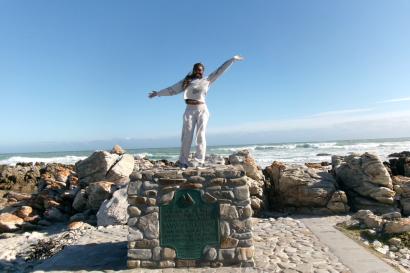I am so, so embarrassingly behind on blog posts. I can’t believe that the last time I posted was when I first started class here at UCT. I am now roughly six weeks into the semester and SO much has happened since then. School has unfortunately picked up so trying to juggle classes and homework on top of doing everything I want to do in this city before I leave, I have been a busy bee! And for the record, yes, I do actually go to class (much more often that I would ideally like to be honest)! So for the next couple of weeks, I’ll be cranking out blog posts to catch up and fill you in on all of the wonderful things I’ve done since the end of February!
In the beginning of March, IES took us on a Robben Island tour. Robben Island was the location of one of the main prisons where political prisoners were held during the apartheid era in South Africa, most notably Nelson Mandela, who was imprisoned there for 18 years of his 27 year sentence. Before the tour started, we had a good bit of time to explore the V&A Waterfront. The Waterfront is one of the prime touristy, high end parts of the city. There’s a big fancy mall, restaurants, sunset cruises, and a bunch of designer, boutique-y shops. We had some fun bopping in and out of the shops for a bit before we boarded the ferry to Robben Island. It was a picture-perfect Cape Town Saturday the day we went, so the 25 minute ferry ride was absolutely delightful. Seeing the city mountainscape from the water was truly breathtaking; I was pretty much captivated by the amazing view for the entirety of the ride.
Upon arriving, I was immediately surprised by how big the island actually was. For some reason in my head, I imagined Robben Island to be an Alcatraz sort of place with nothing but a giant prison on a tiny island. Robben Island is actually roughly 5 kilometers long and there’s much more on the island than just a prison! I was surprised to find out that many of the former prisoners and their families actually still live on the island. There is a church, a school, and a store. There is no police station because apparently there is virtually no crime amongst the residents of the Island. It is pretty remarkable that there is such a strong sense of community amongst these people so near a place filled with many years of unspeakable memories and terrors.
I also learned that Robben Island was actually a leper colony before it was used as a prison. We drove past a graveyard labeled “leper graveyard” which was quite eerie. I actually enjoyed the tour of the property around the prison more than the actual prison itself. We saw the limestone quarry where prisoners, including Nelson Mandela himself, were forced to break up the stone and work with it all day long. A lot of the work they were doing most of the time was pointless, they were instructed to carry the limestone from one end of the quarry to the other just to keep them busy and keep them working. The prisoners had no tools or protective gear when working with the rock, resulting in major vision problems for many of the prisoners due to the sun reflecting off of the lightly-colored limestone. This is why photographers were never allowed to use flash when photographing Nelson Mandela in his later years.
Once we finished the bus tour of the property, we began our tour of the actual prison. One of the most unique things about Robben Island is that all of the tours are led by actual former prisoners. It’s amazing to get to hear their personal stories and experiences on the tour, it makes the experience of being there all the more real. Our tour guide was very friendly and informative, but unfortunately he was pretty soft spoken and had a very thick accent so it was hard to hear and understand a lot of what he was saying. Luckily, the prison in and of itself was quite impactful on its own. The prison was pretty much exactly what I expected. It was dark, sad, and disheartening to be there and to hear the stories of how these prisoners were treated for such minor “offenses”, like participating in political protests. Getting to stand right in front of Nelson Mandela’s cell where he spent 18 years of his life sent shivers up and down my spine.
One of my favorite parts of the prison tour was when we went to a big section of cells that acted as a sort of interactive museum exhibit. In every cell, there was a photo of the prisoner who was assigned to that cell along with a personal story of their experience in prison. I’m so happy I got to read so many of those stories and hear so many perspectives from various prisoners. It was great to have another reminder of how many other important South African civil rights leaders (aside from Mandela) were held in this prison and their stories are just as important to hear and to remember.
It’s kind of odd to say that I “enjoyed” my time on a prison tour, but I really learned so much from visiting Robben Island. Going to the Island was another one of those times for me where I was overcome with gratitude to be able to spend time in this country with so much rich and important history. Not very many people in this world get to step foot on Robben Island and I really feel so honored and fortunate that I am one of them.

Quinn Doyle
<p>My name is Quinn and I am a junior at the University of Mary Washington majoring in Psychology. After undergrad, I hope to get my masters in school counseling. I enjoy reading, cooking, spending time with friends and family, and exploring new places. I cannot wait to see what is in store for me during my semester at the beautiful University of Cape Town! </p>







